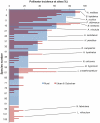Changing bee and hoverfly pollinator assemblages along an urban-rural gradient
- PMID: 21858128
- PMCID: PMC3155562
- DOI: 10.1371/journal.pone.0023459
Changing bee and hoverfly pollinator assemblages along an urban-rural gradient
Abstract
Background: The potential for reduced pollination ecosystem service due to global declines of bees and other pollinators is cause for considerable concern. Habitat degradation, destruction and fragmentation due to agricultural intensification have historically been the main causes of this pollinator decline. However, despite increasing and accelerating levels of global urbanization, very little research has investigated the effects of urbanization on pollinator assemblages. We assessed changes in the diversity, abundance and species composition of bee and hoverfly pollinator assemblages in urban, suburban, and rural sites across a UK city.
Methodology/principal findings: Bees and hoverflies were trapped and netted at 24 sites of similar habitat character (churchyards and cemeteries) that varied in position along a gradient of urbanization. Local habitat quality (altitude, shelter from wind, diversity and abundance of flowers), and the broader-scale degree of urbanization (e.g. percentage of built landscape and gardens within 100 m, 250 m, 500 m, 1 km, and 2.5 km of the site) were assessed for each study site. The diversity and abundance of pollinators were both significantly negatively associated with higher levels of urbanization. Assemblage composition changed along the urbanization gradient with some species positively associated with urban and suburban land-use, but more species negatively so. Pollinator assemblages were positively affected by good site habitat quality, in particular the availability of flowering plants.
Conclusions/significance: Our results show that urban areas can support diverse pollinator assemblages, but that this capacity is strongly affected by local habitat quality. Nonetheless, in both urban and suburban areas of the city the assemblages had fewer individuals and lower diversity than similar rural habitats. The unique development histories of different urban areas, and the difficulty of assessing mobile pollinator assemblages in just part of their range, mean that complementary studies in different cities and urban habitats are required to discover if these findings are more widely applicable.
Conflict of interest statement
Figures







Similar articles
-
Bumble bees (Bombus spp) along a gradient of increasing urbanization.PLoS One. 2009;4(5):e5574. doi: 10.1371/journal.pone.0005574. Epub 2009 May 15. PLoS One. 2009. PMID: 19440367 Free PMC article.
-
Landscape and local site variables differentially influence pollinators and pollination services in urban agricultural sites.PLoS One. 2019 Feb 13;14(2):e0212034. doi: 10.1371/journal.pone.0212034. eCollection 2019. PLoS One. 2019. PMID: 30759171 Free PMC article.
-
Decreasing abundance, increasing diversity and changing structure of the wild bee community (Hymenoptera: Anthophila) along an urbanization gradient.PLoS One. 2014 Aug 13;9(8):e104679. doi: 10.1371/journal.pone.0104679. eCollection 2014. PLoS One. 2014. PMID: 25118722 Free PMC article.
-
Opportunities and threats for pollinator conservation in global towns and cities.Curr Opin Insect Sci. 2020 Apr;38:63-71. doi: 10.1016/j.cois.2020.01.006. Epub 2020 Jan 28. Curr Opin Insect Sci. 2020. PMID: 32126514 Review.
-
The effects of urbanization on pollinators and pollination: A meta-analysis.Ecol Lett. 2023 Sep;26(9):1629-1642. doi: 10.1111/ele.14277. Epub 2023 Jun 22. Ecol Lett. 2023. PMID: 37345567 Review.
Cited by
-
Predicting bee community responses to land-use changes: Effects of geographic and taxonomic biases.Sci Rep. 2016 Aug 11;6:31153. doi: 10.1038/srep31153. Sci Rep. 2016. PMID: 27509831 Free PMC article.
-
Bacterial communities associated with honeybee food stores are correlated with land use.Ecol Evol. 2018 Apr 16;8(10):4743-4756. doi: 10.1002/ece3.3999. eCollection 2018 May. Ecol Evol. 2018. PMID: 29876054 Free PMC article.
-
Insect Decline-Evaluation of Potential Drivers of a Complex Phenomenon.Insects. 2024 Dec 23;15(12):1021. doi: 10.3390/insects15121021. Insects. 2024. PMID: 39769623 Free PMC article.
-
The PREDICTS database: a global database of how local terrestrial biodiversity responds to human impacts.Ecol Evol. 2014 Dec;4(24):4701-35. doi: 10.1002/ece3.1303. Epub 2014 Dec 2. Ecol Evol. 2014. PMID: 25558364 Free PMC article.
-
The evolution of city life.Proc Biol Sci. 2018 Aug 15;285(1884):20181529. doi: 10.1098/rspb.2018.1529. Proc Biol Sci. 2018. PMID: 30111603 Free PMC article.
References
-
- Kearns CA, Inouye DW, Waser NM. Endangered mutualisms: The conservation of plant-pollinator interactions. Annual Review of Ecology and Systematics. 1998;29:83–112.
-
- Potts SG, Biesmeijer JC, Kremen C, Neumann P, Schweiger O, et al. Global pollinator declines: trends, impacts and drivers. Trends in Ecology & Evolution. 2010;25:345–353. - PubMed
-
- Aizen MA, Harder LD. The Global Stock of Domesticated Honey Bees Is Growing Slower Than Agricultural Demand for Pollination. Current Biology. 2009;19:915–918. - PubMed
-
- Kremen C, Williams NM, Aizen MA, Gemmill-Herren B, LeBuhn G, et al. Pollination and other ecosystem services produced by mobile organisms: a conceptual framework for the effects of land-use change. Ecology Letters. 2007;10:299–314. - PubMed
Publication types
MeSH terms
LinkOut - more resources
Full Text Sources

